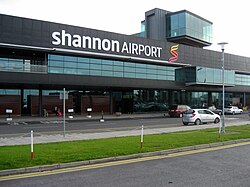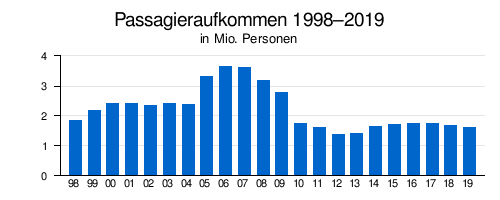Shannon Airport
| Shannon Airport |
|
|---|---|

|
|
| Characteristics | |
| ICAO code | EINN |
| IATA code | SNN |
| Coordinates | |
| Height above MSL | 14 m (46 ft ) |
| Transport links | |
| Distance from the city center | 3 km southwest of Shannon |
| Street | N19 |
| Local transport | bus |
| Basic data | |
| operator | Shannon Airport Authority |
| Terminals | 1 |
| Passengers | 1,616,422 (2019) |
| Air freight | 12,658 t (2019) |
| Flight movements |
13,151 (2019) |
| Runways | |
| 04/22 (closed) |
1970 m × 60 m |
| 06/24 | 3199 m × 45 m asphalt |
| 08/26 (closed) |
1465 m × 45 m |
| 13/31 (closed) |
1720 m × 45 m asphalt |
| 18/36 (closed) |
1713 m × 45 m |
The Shannon Airport ( Engl. Shannon International Airport , ir. Aerfort na Sionna , IATA : SNN , ICAO : EINN ) is an international airport in the west of Ireland . It is located on the river of the same name , 3 km from Shannon , 24 km from Limerick and 90 km southeast of Galway .
Transport links
There is no train stop, only a connection to the bus network. Taxis and rental cars are also available. The journey time to Galway is approx. 2 hours, to Limerick approx. 30–50 minutes, to Ennis approx. 30 minutes and to Doolin approx. One and a half hours.
history
In 1935 the government decided to expand transatlantic air traffic. In 1937 the first flight from Newfoundland to the Foynes airboat port on the Shannon River took place, and two years later a test flight to the new Rineanna airfield took place. Although civil aviation was discontinued during the Second World War , the airfield was expanded further. After the war ended, airlines replaced their flying boats with land planes. Since then, Shannon Airport has played an important role in transatlantic air traffic.
The first regular flight from Gander to Newfoundland took place on September 16, 1945 . At that time the range of the aircraft was limited to approx. 4000 to 6000 kilometers, depending on the type, which is why the shortest connection between Western Europe and Eastern North America had to be used. Shannon initially served as a stopover for many airlines until the 1960s, as the short range of the jets did not allow non-stop flights. Towards the end of the 1950s, the first commercial aircraft with sufficient range came into use and Shannon's importance as a transatlantic hub declined because the major airports could now be reached non-stop.
Airlines and Destinations
In addition to some regional and sometimes seasonal European connections, Shannon also has a number of long-haul connections to North America that is remarkable for its size . Aer Lingus flies to New York-JFK and Boston , United Airlines also serves New York-Newark . Delta Airlines fly to New York-JFK and American Airlines fly to Philadelphia . The high number of home visits by Irish people living in the USA plays a major role here. British Airways uses the airport as a refueling stop for transatlantic flights between London City Airport and JFK with a specially converted Airbus A318 . During this stopover, entry into the USA is handled by the American Border Protection Agency, so that passengers can enter New York without any further formalities.
Military use
The United States used the airport until mid-2006 to transport troops to combat missions in Afghanistan and Iraq . In the first quarter of 2006 alone , more than 160,000 soldiers had passed the airport, which was double that of the previous year. This made Ireland an important transit point for US troops on the way to the Middle East .
During the operating period of the Space Shuttle of NASA , the airport was a possible emergency landing in the event of an unscheduled landing.
Traffic figures

| year | Passenger volume | Air freight ( tons ) (with airmail) |
Flight movements |
|---|---|---|---|
| 2019 | 1,616,422 | 12,658 | 12,658 |
| 2018 | 1,677,661 | 13,592 | 13,699 |
| 2017 | 1,751,500 | 18,998 | 13,229 |
| 2016 | 1,748,935 | 12,591 | 13,604 |
| 2015 | 1,714,872 | 12,270 | 16,692 |
| 2014 | 1,639,315 | 10,886 | 15,605 |
| 2013 | 1,400,032 | 13,921 | 12,648 |
| 2012 | 1,394,781 | 16,100 | 24,264 |
| 2011 | 1,625,453 | 16,600 | 27,846 |
| 2010 | 1,755,885 | 20,000 | 27,382 |
| 2009 | 2,794,563 | 18,900 | 34,966 |
| 2008 | 3,169,529 | 23,200 | 42,359 |
| 2007 | 3,620,623 | 27,000 | 48.114 |
| 2006 | 3,639,046 | 31,100 | 46,715 |
| 2005 | 3,302,424 | 29,300 | 45.093 |
| 2004 | 2,395,116 | - | 35,818 |
| 2003 | 2,400,677 | 47,473 | 37,641 |
| 2002 | 2,353,530 | 48.094 | 36,863 |
| 2001 | 2,404,658 | 50.181 | 47,984 |
| 2000 | 2,408,252 | 53,398 | 53,867 |
| 1999 | 2,188,154 | 45,974 | 51,414 |
| 1998 | 1,840,008 | 44,037 | 45,776 |
- ↑ Until 2012, freight until 2003
Incidents
From 1943 to January 2020, there were 17 total write-offs of aircraft at Shannon Airport and in its vicinity. 188 people were killed in 6 of them. Examples:
- On September 5, 1954, a Lockheed L-1049C Super Constellation of the Dutch KLM ( aircraft registration PH-LKY ) had an accident on its flight from Shannon to New York-Idlewild Airport . The machine hit the mud of the River Shannon at takeoff 31 seconds after flying over the end of the runway . In the accident, 28 of the 56 occupants were killed, 3 crew members and 25 passengers. The rescue work was only initiated after the navigator had fought his way through the river delta to the airport. Reasons were premature retraction of the landing flaps and premature reduction in engine power as well as a warning light that had been defective for a long time for the retraction status of the landing gear (see also KLM flight 633 ) .
- On July 15, 1956, a brand-new Convair CV-440 from the Swiss airline Swissair (HB-IMD) was on its transfer flight to Switzerland. Coming from Gander , it crashed on the approach to Shannon Airport when the final approach curve was flown very deep and too steep and it came to a stall . The four crew members, three Americans and one Swiss, died. Fatigue was identified as a contributing accident factor.
- On February 26, 1960, a Douglas DC-7C of the Alitalia (I-DUVO) crashed for unknown reasons on the way from Rome via Shannon to New York-Idlewild shortly after taking off from Shannon. Of the 52 people on board, 34 died.
- On September 10, 1961, a Douglas DC-6B of the US President Airlines (N90773) crashed about a minute after taking off from Shannon Airport. The machine was supposed to fly to Gander ( Newfoundland ) and got into an increasingly steep left turn until it finally crashed 1500 meters from the runway into the River Shannon at an angle of about 90 °. All 83 people on board, 6 crew members and 77 passengers, were killed. The cause of this second worst accident involving a DC-6 is assumed to be a technical defect.
- On September 30, 1977, a Bristol Britannia 253 operated by Irish Interconair (EI-BBY) experienced strong vibrations shortly before landing at Shannon Airport. The approach was canceled and a go- around was initiated. The machine continued to sink, however, hit the runway and jumped up again, breaking off the right wing. It kept sliding, caught fire, and burned out. All 6 occupants, 4 crew members and 2 passengers survived the serious accident.
Web links
Individual evidence
- ↑ a b c d e Aviation Statistics. CSO.ie , accessed June 9, 2020 .
- ↑ IMI analysis 2009/005: The military hub Halle / Leipzig ( Memento from February 6, 2009 in the Internet Archive )
- ^ Justine Whitman: Space Shuttle Abort Modes. Aerospaceweb.org, June 25, 2006, accessed October 7, 2011 .
- ↑ a b Traffic Figures. ShannonAirport.ie, accessed November 14, 2018 .
- ^ Aviation Statistics Archive. CSO.ie , accessed June 9, 2020 .
- ↑ Accident statistics at Shannon Airport , Aviation Safety Network (English), accessed on February 16, 2020.
- ↑ ICAO Aircraft Accident Digest No. 7, Circular 50-AN / 45, Montreal 1957 (English), pp. 20-34.
- ^ Accident report L-1049 PH-LKY , Aviation Safety Network (English), accessed on December 21, 2019.
- ↑ Air-Britain Archive: Casualty Compendium (English) Part 67, December 1997 pp. 97/112.
- ^ Accident report CV-440 HB-IMD , Aviation Safety Network (English), accessed on August 20, 2017.
- ^ Accident report DC-7C I-DUVO , Aviation Safety Network (English), accessed on November 24, 2017.
- ↑ accident report DC-6B N90773 , Aviation Safety Network (English), accessed on 18 December 2018th
- ^ Accident report Britannia 253 EI-BBY , Aviation Safety Network (English), accessed on February 16, 2020.
